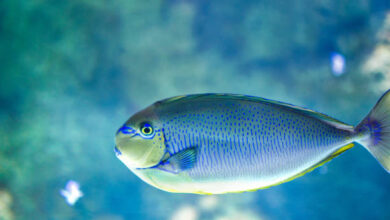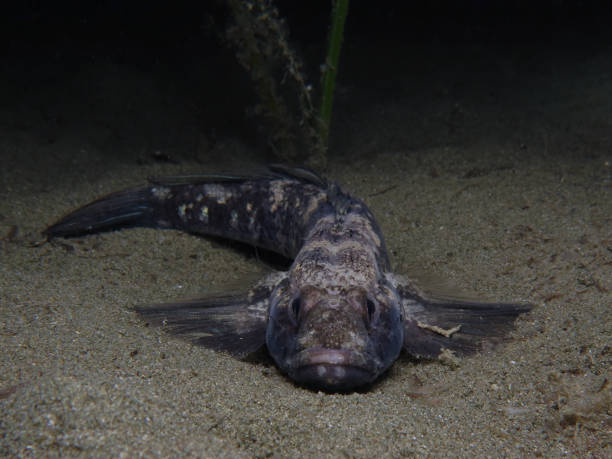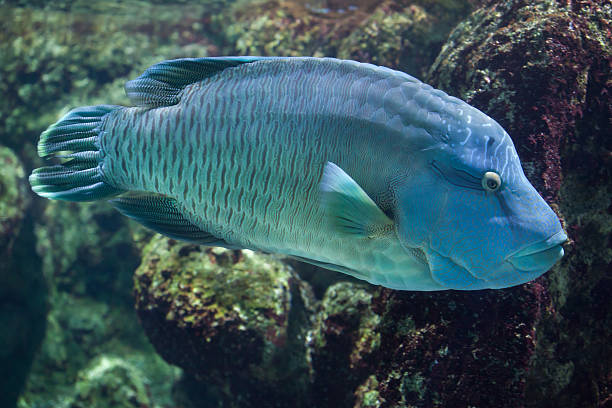Which fish with lobe fins is still alive?
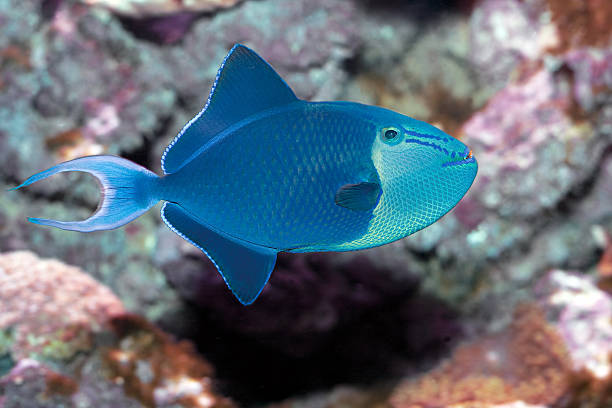
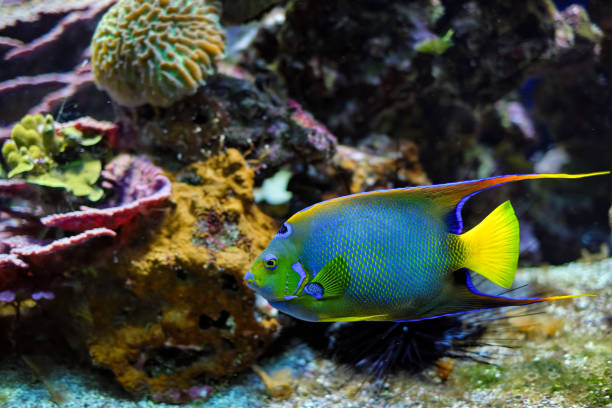 Numerous species found in the aquatic realm have a long evolutionary history, with many dating back millions of years. The lobe-finned fish are one such species. Still, have you ever wondered which living lobe-finned fish? The coelacanth is the solution. This ancient animal, which was formerly believed to be extinct millions of years ago, is still present in our waters today and fascinates both scientists and ocean lovers.
Numerous species found in the aquatic realm have a long evolutionary history, with many dating back millions of years. The lobe-finned fish are one such species. Still, have you ever wondered which living lobe-finned fish? The coelacanth is the solution. This ancient animal, which was formerly believed to be extinct millions of years ago, is still present in our waters today and fascinates both scientists and ocean lovers.
Comprehending Fish with Lobe Fins
Explore the intriguing realm of lobe-finned fish, or Sarcopterygii as they are scientifically called. These amazing species differ from their counterparts, the ray-finned fish, in that they have fleshy, lobe-like fins supported by a central core of bones. The way that our evolutionary narrative interacts with that of lobe-finned fish is what makes it so intriguing. You heard correctly! These aquatic animals’ lobed fins were crucial to the evolution of tetrapods, a group that comprises all modern land-dwelling vertebrates, including humans! Over time, these fins changed into limbs.
Lobe-finned fish were the dominant species in the aquatic environment when they lived approximately 360 million years ago, during the Devonian epoch. But as time has gone on, their population has drastically decreased, leaving us with just two species: lungfish and coelacanths.
However, what has allowed these two particular species of lobe-finned fish to survive in the oceans of today? Both scientists and fish aficionados are curious to know the answer to that question. Furthermore, the more we understand about these species, the more our own evolutionary history becomes clear.
Every new finding and observation completes a piece of the evolutionary puzzle. So, are you ready to take on this aquatic voyage with me and explore the world of the lobe-finned fish in greater detail?
The biology and distinctive traits of the two remaining lobe-finned fish species, lungfish and coelacanths, will be discussed in the following sections. These remarkable species represent the key to many of the evolutionary riddles that remain to be solved. First, let’s head to the ocean floor, home of the coelacanths, also known as “living fossils,” and then let’s head to the shallow seas and marshes to meet the lungfish.
These two intriguing lobe-finned fish are examples of how adaptable and hardy life is on Earth. Join us as we explore the many environments of this endangered species, the traits that have contributed to their survival, and how our knowledge of the biology of lobe-finned fish might help us decipher the evolutionary relationships that these fish have with humans.
Get ready for an exciting journey into a prehistoric undersea world that has been developing for hundreds of millions of years. Every habitat, from the vast, enigmatic oceans to the varied, lush wetlands, reveals a new phase in the life of the lobe-finned fish. Together, let’s explore the pages of our common evolutionary history by swimming along their historical tide.
Coelacanth, the Living Fossil
Explore the mystique surrounding the coelacanth, one of the two species of lobe-finned fish that still exist. Since the sole evidence of these animals was in the form of fossils that date back an astounding 65 million years, the scientific community long believed that they had vanished from the face of the earth. That all changed, though, in 1938, when a fisherman off the coast of South Africa brought in a specimen that would change history: a coelacanth that was alive and breathing.
The field of marine biology was rocked by this enormous finding. This was a monster that was living and swimming in the deep depths, thought to be extinct since the time of the dinosaurs. This kind of thing happened so rarely that the coelacanth was given the nickname “living fossil.” You may question, why this name? Well, that’s because, throughout their 300 million-year history, coelacanths have undergone very little, if any, alteration.
Please give that some thought. Over eons, coelacanths have withstood extreme changes in their morphology, while surrounding species have changed, evolved, or vanished completely.
As we examine this amazing fish’s traits, habits, and state of conservation, keep in mind that you’re learning about more than simply an interesting species. You are delving into a period of our planet’s history that spans hundreds of millions of years, during which the ancestors of modern people were still figuratively and physically getting their bearings.

Now, when we delve more into the realm of the Coelacanth, the “living fossil,” isn’t it something to consider? As we continue, we will discover the special characteristics that characterize the lobe-finned fish family and account for the coelacanths’ remarkable resilience and enigmatic existence. This journey will undoubtedly push the boundaries of our knowledge and provide insight into this amazing aquatic phenomenon.
So come along as we explore the mysteries of the deep sea that surround this remarkable lobe-finned fish. We’ll work together to delve further into the past and reveal the fascinating tale of the coelacanth’s survival. We’ll learn about the amazing adaptations and survival techniques of this hardy lobe-finned fish as we set out on this adventure.
We’re delving into an old story of tenacity and perseverance, not just studying a creature. Discover more about the coelacanth’s survival strategies on these pages, and learn why this lobe-finned fish is regarded as a living example of life’s incredible resiliency. As we travel through this fish’s incredible voyage through time, get ready to submerge yourself in a sea of information.
Physical attributes specific to coelacanths
Now let’s take a closer look at the physical characteristics that really set the Coelacanth apart. These inhabitants of the deep water can grow to a maximum length of 6.5 feet and a maximum weight of about 200 pounds, making them fairly large. That weighs nearly the same as a refrigerator that is full size!
Their distinctive lobe-fins, which resemble limb-like appendages, allow for an uncommon mode of mobility in addition to serving as a distinctive distinguishing characteristic. Rather than swimming gracefully like most fish, coelacanths move through the water more like “crawling.” It appears as though they are strolling at a leisurely pace, well below the ocean’s surface!
These ancient creatures have a remarkable armor of thick, durable scales covering their body, which offers them strong defense from any predators that might be hiding in the depths.
Furthermore, we truly mean it when we describe something as “armor-like”! A Coelacanth’s outer layer is so strong that it’s been compared to the durability of a knight’s armor.
The’second brain’ of coelacanths is one feature that really sets them apart. But don’t be misled by the phrase. It’s a fat-filled chamber situated above the brain, not another thinking organ. This fatty reservoir is one of the many physical traits that distinguish the Coelacanth from its aquatic cousins, even though it is not engaged in cognitive function.
With its unique morphological attributes, the coelacanth is not your average fish in the sea. It is evidence of a bloodline that has endured for ages, a living link tying us to the past. Therefore, as we learn more about the details of this “living fossil,” we are not only solving the puzzles surrounding the origins of a novel species but also the mysteries surrounding our own evolutionary history. Let’s now resume our voyage through the deep blue, revealing many more Coelacanth mysteries along the way.
The Habitat and Behavior of Coelacanths
Imagine diving hundreds of meters below the surface of the ocean into complete darkness. Here, at a depth of up to 700 meters, is where the coelacanth’s domain is found. These “living fossils” prefer the cover of underwater caverns or nooks, which provide a peaceful haven away from the commotion of the thriving marine life above. However, don’t let their laid-back appearance throughout the day fool you. The coelacanths wake up from their sleep when night falls and begin their nocturnal hunt. They creep out from under their rocky shelters and stalk their prey, which is mostly squid and tiny fish.
One peculiarity of these extinct swimmers is the way they reproduce. Coelacanths reproduce by ovulation. Though it sounds fancy, this phrase only indicates that the eggs hatch inside the female. Then, in a rare event for fish species, the young are born alive. It is yet another characteristic that distinguishes these extinct animals and emphasizes the mystery surrounding the coelacanth.
We are able to appreciate the coelacanth’s pure wonder as each facet of their behavior and environment detail contributes another brushstroke to the detailed painting of this amazing animal.
Thus, let us bear in mind the coelacanth, a symbol of tenacity and a lighthouse pointing to our evolutionary history, as we venture more into the ocean’s depths and the enigmas surrounding evolution. This living fossil, a lobe-finned fish, represents an evolutionary lineage that extends over 360 million years.
Its remarkable survival and adaptability highlight the complicated and complex processes that life on Earth has gone through. The limb-like fins of coelacanths, fish with lobe fins, suggest that they made the evolutionary transition from sea to land, emphasizing their ancestry to terrestrial vertebrates. Their tale does provide a thorough exploration of the rich biological history of the planet.
This amazing voyage shows us how all life on Earth, even lobe-finned fish, has changed over hundreds of millions of years. The coelacanth’s continued existence is a source of inspiration, suggesting that the ocean’s depths may still contain evolutionary surprises. Thus, we continue our research and learn more about the mysterious lobe-finned fish and the evolutionary stories encoded in their genomes.
What mysteries do they conceal, and how might they add to our knowledge of the abundant biodiversity of Earth? Additional research on the genetic composition of these lobe-finned fish may reveal startling new information about their long-term survival tactics.
This exciting possibility is what keeps us going on this fascinating exploration journey and satisfies our desire for more knowledge.
The Coelacanth’s State of Conservation
Join us as we embark on a more gloomy chapter of the coelacanth’s story: their fragile position in the contemporary world. According to the International Union for Conservation of Nature (IUCN), these amazing animals are ‘critically endangered’ and are facing numerous, increasing difficulties. Sadly, despite their extraordinary survival rate and long history, they are still vulnerable to modern challenges.
The main victims of the dangers of deep-sea fishing are coelacanths. These ‘living fossils’ frequently become unintentional catches as fishing nets descend farther into the water. The attractiveness of their rarity and scientific value is greater than their awful greasy flesh, which should have served as a natural deterrent. This is an unfortunate twist of fate.
Even though coelacanths are inedible, their unusual status makes them an enticing target for illicit trade.
Unfortunately, these interesting species are frequently drawn into the sneaky web of illicit market trafficking as well as actual physical nets. Unchecked curiosity and the pursuit of knowledge can occasionally put the very things we want to learn about and comprehend at jeopardy.
It’s important to keep in mind that a coelacanth is more than just one fish. It’s a piece of history, an opportune window into the age-old tale of evolution.
Preserving a living example of our planet’s amazing past is what these ancient swimmers’ existence means, not just the survival of a species.
It’s critical that we continue to be dedicated to protecting the amazing species that inhabit this planet as we explore the depths of the ocean and the secrets surrounding our own evolutionary history. The coelacanth is still fighting for its life, but with enough knowledge and effort on our part, we can make sure that these “living fossils” survive and continue to fascinate and instruct us for many years to come.
The Coelacanth: An Evolutionary Window
Examine the fascinating realm of evolution via the Coelacanth’s eyes. This amazing animal provides a living window into a time when life was shifting from the ocean’s depths to the land, since one of the oldest fish species on the planet is still extant. We have a rare chance to learn more about the limb metamorphosis of tetrapods and gain insight into the early evolutionary history of our own species by researching the coelacanthus.
The Coelacanth is essentially an ancient fish that can be used as a biological time machine to solve some of the most profound evolutionary questions. Its resilience and ongoing existence serve as a constant reminder of the amazing biodiversity of our world and the need of safeguarding it. By learning about, protecting, and honoring the coelacanth, we are delving deeply into the intricate and fascinating story of life on Earth rather than merely learning about one particular species.
The Coelacanth keeps lighting our way as we make our way through the maze of evolution, teaching us about the past and motivating us for the future. Thus, let’s keep investigating, appreciating, and protecting this incredible “living fossil”—our one-of-a-kind window into the fascinating realm of evolution.
